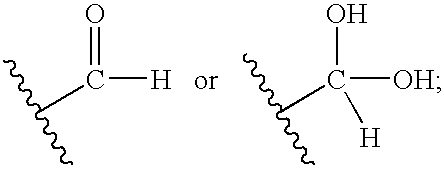Quinazoline derivatives useful for the treatment of peripheral arterial disease and as phosphodiesterase inhibitors
a technology of phosphodiesterase inhibitors and derivatives, which is applied in the direction of plant growth regulators, biocide, animal husbandry, etc., can solve the problems of intermittent claudication, restricting blood flow, and reducing the delivery of oxygen and nutrients to the various organs and tissues of the body
- Summary
- Abstract
- Description
- Claims
- Application Information
AI Technical Summary
Problems solved by technology
Method used
Image
Examples
example 1
Preparation of Compound #1 of the Present Invention
[0079] The Compound #1 N-(5,6-dichloro-3,4-dihydroquinazolin-2-yl)-2-oxoacetamide (1) having an m / z of 271 was synthesized. Compound #1 may also exist as its hydrate (2).
[0080] This approach to the required aldehyde (1) involved the reaction of 2-amino-5,6-dichloro-3,4-dihydroquinazoline (A) with glyoxalic acid hydrate (B) using a dicyclohexylcarbodiimide (DCC)-type coupling approach.
[0081] The coupling of (A) and glyoxalic acid (B) was conducted using dicyclohexylcarbodiimide (DCC), dimethylaminopyridine (DMAP) in dichloromethane (DCM). Product (A) can be obtained by methods known in the art (see, for example, U.S. Pat. No. 6,194,420, issued Feb. 27, 2001). A small amount of dimethylformamide (DMF) was added to aid the solubility of product (A). When these reagents were mixed in the dichloromethane solvent, a precipitate formed. This precipitate was filtered and the solvent evaporated. This crude reaction mixture was analyzed ...
example 2
Alternative Synthesis of Compound #1
[0085] Step 1
[0086] RL603 can be reliably acylated in modest to good yield by using 2.2 equivalents of sodium hydride and 1.1 equivalents of ethyl 2,3-isopropylidene glycerate to yield the product B (Scheme 1). The anion of RL603 was formed by heating with the sodium hydride in THF at 50° C. for 30 min under an inert atmosphere. Then the mixture was cooled to room temperature, the ester was added, and the reaction stirred for 3 days. Quick purification and usage of the products is preferable in order to avoid formation of fluorescent oxidized impurities. Purification was achieved by normal aqueous extraction and chromatography on silica (eluting with 40-50% ethyl acetate / 60-50% petrol).
[0087] The ethyl 2,3-isopropylidene glycerate was prepared. 1,2:5, 6-Di-isopropylidene-mannitol was treated with either sodium periodate or tetra-butylammonium periodate followed by potassium permanganate to yield crude potassium isopropylidene-glycerate, which...
example 3
Synthesis 6,7-dichloro-3-hydroxy-1,5-dihydro-imidazo[2,1-b]quinazolin-2-one (compound#3)
[0092]
Reagents and Conditions:
[0093] Step (i): KMnO4, KOH, water, room temperature (rt), 4 h, filter and evaporate, then DMF, ethyl iodide, rt, overnight, aqueous work-up, 56% yield overall.
[0094] Step (ii): 2-amino-5,6-dichloro-3,4-dihydroquinazoline,
NaH, THF, 50° C., 30 min, then rt, 48 h, aqueous work-up and column chromatography, 50% yield.
[0095] Step (iii): CF3CO2H, water, rt, 1 h, evaporate, freeze-dry and triturate with ether, 100% yield.
[0096] Step (iv): NaIO4, pH 5.1 buffer, acetone, 10° C., 20 min, evaporate, freeze-dry and column chromatography, 31% yield.
Purification
[0097] Chromatographic isolation of product (resolution from the isomer compound#5 (6,7-Dichloro-1-hydroxy-3,5-dihydro-imidazo[1,2-a]quinazolin-2-one was performed on normal phase silica in a glass column under compressed air pressure, eluting with a gradient of 0-10% methanol / 100-90% ethyl acetate. The fractio...
PUM
| Property | Measurement | Unit |
|---|---|---|
| platelet aggregation | aaaaa | aaaaa |
| tautomers | aaaaa | aaaaa |
| chemical functional | aaaaa | aaaaa |
Abstract
Description
Claims
Application Information
 Login to View More
Login to View More - R&D
- Intellectual Property
- Life Sciences
- Materials
- Tech Scout
- Unparalleled Data Quality
- Higher Quality Content
- 60% Fewer Hallucinations
Browse by: Latest US Patents, China's latest patents, Technical Efficacy Thesaurus, Application Domain, Technology Topic, Popular Technical Reports.
© 2025 PatSnap. All rights reserved.Legal|Privacy policy|Modern Slavery Act Transparency Statement|Sitemap|About US| Contact US: help@patsnap.com



